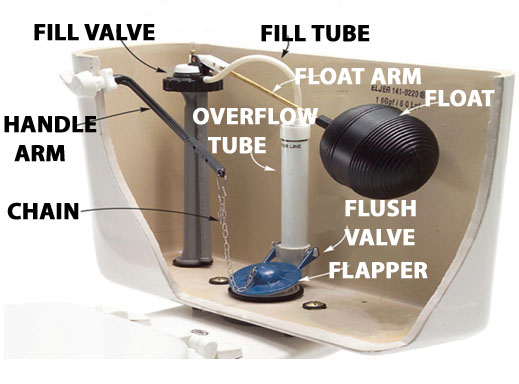A running or leaky toilet wastes a lot of water and can add hundreds (even thousands) of dollars to your bill. For many homeowners, fixing a leaking toilet is a do-it-yourself project. It requires no special tools and usually costs less than $20. If you are a renter, report the leak to your landlord right away.
Signs of a running toilet
If you notice any of the following telltale signs, you have a leak (or a leak waiting to happen):
- You hear your toilet tank refilling constantly or between flushes
- You see water flow or dribble into the bowl even when you haven’t flushed it
- You have to jiggle the handle to get the toilet to stop running
- You see or feel that the rubber valve between the tank and the bowl (called a flapper) is starting to show signs of wear
Test for a slow leak with food coloring
If you still suspect a leak or your toilet is somewhere you wouldn’t hear it refill between flushes, you can use food coloring to check for a slow leak. Remove the toilet tank lid and put several drops of food coloring in the tank. Replace the lid but don’t flush the toilet and wait at least 10 minutes. If you see color in the bowl, you have a leak, probably from the flapper.

Repair a running toilet
Check the water level
With the tank lid off, flush your toilet and note the water height when it stops refilling. The water level in your toilet tank should be set to the fill line marked on the tank or the overflow tube. If the water level is set above the top of the overflow tube your toilet will run continuously.
You can adjust the float height to change the water level as necessary. If the water level is okay and your toilet is still running, you likely need to check the flapper.
Check the flapper
Most running toilets are caused by a worn-out flapper.
The flapper is a valve that seals water in the toilet tank between flushes. Over time, the flapper in your toilet will break down and let water leak from the tank into the bowl and down the drain. Sometimes an old flapper will seal well after some flushes and not others, so it can be hard to catch a running toilet. We recommend replacing your flapper every 5 years to prevent leaks.
If the flapper looks okay, the chain connected to the flapper may not be properly adjusted. The handle may also be too loose. If the flapper doesn’t easily fall into place after flushing, try adjusting the length of the chain or tightening the nut behind the handle.
Replace the flapper
A new flapper usually costs less than $10 at your local hardware store. You don’t need any special tools to install it. Bring your old flapper with you to the hardware store to make sure you buy a new flapper that fits your toilet model.
You can also buy a complete toilet repair kit to replace all the parts in the tank. These kits usually cost less than $20 at your local hardware store.
If your flapper is worn out or not sealing correctly and you need to replace it, you can do it yourself:
- Turn off the water to your toilet at the wall
- Remove the tank lid and flush the toilet to drain the water
- Disconnect the chain from the flush arm (for most toilet models) and remove the flapper
- Bring your old flapper with you to the store to buy a new one
- Install the new flapper, reconnect the chain, and turn the water back on
- Replace the lid and flush to make sure the toilet is working correctly
When to replace your toilet
Consider buying a new toilet if your current toilet:
- Has recurring leaks (even after you’ve repaired them)
- Needs two flushes to clear the bowl
- Is more than 20 years old
Some low-flow toilets got a bad reputation in the 1990s for poor performance and the dreaded double flush. Thanks to better design, today’s low-flow toilets work better and use even less water.
If your toilet was manufactured before 2004, you may be eligible for a rebate.




